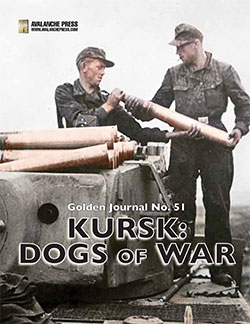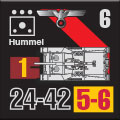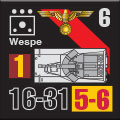| Golden Journal No. 51:
Kursk: Dogs of War
Publisher’s Preview
by Mike Bennighof, Ph.D.
January 2023
 With the help of a “quiet benefactor,” we’re delivering something very different in Golden Journal No. 51, Kursk: Dogs of War. The typical Golden Journal with a Panzer Grenadier theme comes with 24 die-cut and silky-smooth pieces, just like the ones we put into the games. It’s free to the Gold Club when we first offer it, and then afterwards, they have to pay for it just like any other product, but it’s always exclusive to the Gold Club. We never sell it to anyone outside the Gold Club, and we never put it on sale. With the help of a “quiet benefactor,” we’re delivering something very different in Golden Journal No. 51, Kursk: Dogs of War. The typical Golden Journal with a Panzer Grenadier theme comes with 24 die-cut and silky-smooth pieces, just like the ones we put into the games. It’s free to the Gold Club when we first offer it, and then afterwards, they have to pay for it just like any other product, but it’s always exclusive to the Gold Club. We never sell it to anyone outside the Gold Club, and we never put it on sale.
Kursk: South Flank is one of the centerpieces of the Panzer Grenadier series, featuring the attacks of the German II SS Panzer Corps against the south flank of the Soviet defenses. It’s filled with tank battles - the very essence of hex-and-counter wargaming - and we’re currently bringing it back into print in a revised Playbook edition. If you love pushing tanks across a wargame map, this is your game.
In Kursk: South Flank, the SS pieces are in the camouflage color scheme we use across the Panzer Grenadier line for the SS party militia. For Kursk: Dogs of War, our benefactor wanted them in the black color scheme we used in Dishonor Before Death, and so that’s what we’ve done. There are 176 of them: the 172 SS pieces from South Flank, three additional self-propelled artillery pieces, and a special American leader piece in tribute to our benefactor.
  
These are the unique die-cut and silky-smooth pieces for which Avalanche Press has become known: so smooth on the back, that we have to put a color stripe on the back since there’s no massive bathtub-deep trough to tell you which side is which. We’ve done alternative color schemes before (our IDF: Israel Defense Forces book features a full set of 254 Israeli pieces for 1967: Sword of Israel in blue rather than white), but this isn’t one I would have chosen without the special request.
The II SS Panzer Corps entered the Battle of Kursk with three panzer grenadier divisions, each of them better equipped than an Army panzer division. Between them they fielded 390 tanks and 104 assault guns; among the Army divisions, only the similarly-favored Panzer Grenadier Division Grossdeutschland matched their armored strength.
 And with all of those resources, the militiamen achieved comparatively little. Several days of fierce fighting left them short of their objectives. The Battle of Prokhorovka would later be called history’s greatest tank battle, though this is not true (the claim’s based on erroneous Soviet estimates of German tank strength). It was still a very large tank battle. And with all of those resources, the militiamen achieved comparatively little. Several days of fierce fighting left them short of their objectives. The Battle of Prokhorovka would later be called history’s greatest tank battle, though this is not true (the claim’s based on erroneous Soviet estimates of German tank strength). It was still a very large tank battle.
Prokhorovka would also be called a German “tactical victory,” since the Soviets suffered heavier casualties, but the Germans failed to reach their objectives while the Soviets were able to conduct their planned counter-offensive on schedule. A “tactical victory,” with Germany on the verge of losing the war, meant nothing. Anything short of a breakthrough was a failure.
 Historians Karl-Heinz Frieser and Ben Wheatley have argued that the militia won a clear victory at Prokhorovka, based on the ratio of casualties inflicted on either side. But battles, unlike wrestling matches, aren’t won on points. And the lower level of German losses raises the question: if the Germans still had so many operational tanks, why did they not press forward to take their objectives? Historians Karl-Heinz Frieser and Ben Wheatley have argued that the militia won a clear victory at Prokhorovka, based on the ratio of casualties inflicted on either side. But battles, unlike wrestling matches, aren’t won on points. And the lower level of German losses raises the question: if the Germans still had so many operational tanks, why did they not press forward to take their objectives?
In Kursk: Dogs of War, we’ll look at the historical debates over the battle and its outcome, and the SS Panzer Corps that fought there. The Armed SS were not part of the German armed forces, though they fought under the Army’s overall command. They were the Nazi Party’s armed wing, its militia, and through their political influence they had acquired tanks and other heavy equipment to construct three well-equipped mechanized divisions.
 And the three divisions went into the battle with the best tanks Germany’s arsenal could provide in the summer of 1943: Panzer IIIJ medium tanks with the long-barreled 50mm gun, Panzer IVF2 and Panzer IVH medium tanks with the long-barreled 75mm gun, and the new Tiger heavy tanks with their 88mm gun. Germany had finally provided its tank crews with the weapons to match (and overwhelm) the Soviet T34 But even the favored party militia had to round out their tank battalions with captured and refurbished Soviet T34’s. And the three divisions went into the battle with the best tanks Germany’s arsenal could provide in the summer of 1943: Panzer IIIJ medium tanks with the long-barreled 50mm gun, Panzer IVF2 and Panzer IVH medium tanks with the long-barreled 75mm gun, and the new Tiger heavy tanks with their 88mm gun. Germany had finally provided its tank crews with the weapons to match (and overwhelm) the Soviet T34 But even the favored party militia had to round out their tank battalions with captured and refurbished Soviet T34’s.
By the time of Operation Citadel, the attack at Kursk, the SS Panzer Corps had existed for just short of a year. It formed in July 1942 in France, and saw its first action in February 1943 at Kharkov, helping to recapture the city. Afterwards, the three divisions withdrew from the front to rest and re-equip in preparation for the Kursk offensive; to help raise morale, the SS concentration camps sent hundreds of watches taken from Jews to distribute among the militiamen at the front.
 At Kursk, therefore, the three SS divisions had relatively little experience in armored combat. They would soon make up for that – while there are arguments about the outcome of the battle at Prokhorovka, no one disputes its intensity, and the intensity of the fighting over the days that followed. So Dogs of War also has some more scenarios for Kursk: South Flank. At Kursk, therefore, the three SS divisions had relatively little experience in armored combat. They would soon make up for that – while there are arguments about the outcome of the battle at Prokhorovka, no one disputes its intensity, and the intensity of the fighting over the days that followed. So Dogs of War also has some more scenarios for Kursk: South Flank.
The Golden Journal is for our hard-core fans, and that gives us a little more freedom in designing scenarios and such than we might feel that we have in the games and books. So I’ve used this broader canvas to make the little book’s scenarios extra-large, designed for team play and drawing on both South Flank and Burning Tigers for maps and pieces, and using both the camouflage and black SS pieces together (to represent different formations). The Panzer Grenadier series has plenty of fast-playing, one-map scenarios; I think there’s room for a few (though probably only a few) at the other end of the size spectrum.
 All told, it’s a very different sort of package. It’s not one I would have thought to create on my own, but it should provide some extra fun to Kursk: South Flank and give our Gold Club something extra and unusual. All told, it’s a very different sort of package. It’s not one I would have thought to create on my own, but it should provide some extra fun to Kursk: South Flank and give our Gold Club something extra and unusual.
The best part of the Golden Journal is that it’s free – that’s right, free – to the Gold Club, at least when we first offer it. After that, you have to pay for it.
The Golden Journal is only available to the Gold Club (that’s why we call it the Golden Journal).
Click here to join the Gold Club.
See your Gold Club Insider newsletter for ordering information.
Sign up for our newsletter right here. Your info will never be sold or transferred; we'll just use it to update you on new games and new offers.
Mike Bennighof is president of Avalanche Press and holds a doctorate in history from Emory University. A Fulbright Scholar and NASA Journalist in Space finalist, he has published a great many books, games and articles on historical subjects; people are saying that some of them are actually good.
He lives in Birmingham, Alabama with his wife, three children, and new puppy. He misses his lizard-hunting Iron Dog, Leopold.
Want to keep Daily Content free of third-party ads? You can send us some love (and cash) through this link right here.
|
